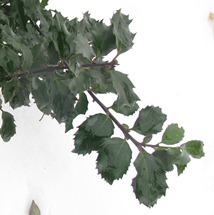Holly (Ilex x meserveae) is often used for holiday decorations, but makes a great plant for any landscape. It is a great plant to use for wonderful winter interest throughout January and February, as well as in December for the holidays.
Holly or meserve holly, has male and female plants. The male plant cultivars are 'Blue Prince', 'Blue Boy', or 'China Boy' and the female plant cultivars are 'Blue Princess', 'Blue Girl', or 'China Girl'. To have fruits, you must have both plants of this cultivar because only the female produces fruit and it must be pollinated by a nearby male plant. The fruit is one of the main reasons that these plants are used in landscapes. Female holly plants have bright red, small, ball-shaped fruits that set in the fall and persist throughout the winter months. If you do not want to have to worry about planting both male and female plants in close proximity, there is one cultivar that is self-fruitful - 'Berry-Magic Kids'- but this cultivar is a dwarf cultivar that only grows to about four feet tall.
Ilex x meserveae is a broadleaf evergreen shrub, which means that it has leaves like a deciduous tree instead of needles like a conifer, but the leaves last throughout the winter months. The leaves are glossy green with spines on each of the points of the leaf. Most meserve hollies grow up to about 10-12 feet tall, but 'Berry-Magic Kids' grows up to only 3-4 feet tall. Hollies bloom in May, but the flowers are small, dull, and white. The flowers are not the focal point of this plant; it is planted for the beautiful green leaves that last all year and the bright red fruits in the winter.
Carefully consider the site when planting meserve holly. It must be planted in part to full shade. The plant will fruit better if it is in part shade or in an area that gets six hours of sunlight per day. You also need to be sure to plant it in an area where it is not exposed to strong winter winds. The leaves on this plant will succumb to winter desiccation if planted in a site with too much sunlight or too much wind. Hollies typically are used as a hedge plant, a mass of plants for a large focal point, or as a specimen plant. Also, if you have a problem with deer in your landscape this is a great plant to use because it is deer resistant. Try to use this plant in your acreage landscape in one or more of these methods - just be sure to plant it in a protected location. However, do be careful when planting this plant if you have children or pets because the berries are very poisonous if they are eaten.
According to Monrovia, the company that introduced 'Blue Prince' and 'Blue Princess' to America, this plant has significant historical value for its use at Christmas. According to the company, the ancient Celts and Britons considered the holly sacred because it is one of the few broadleaf evergreens. The ancient Celts and Britons believed that because this plant was still alive through the winter when all other broadleaf plants were dead, it was a symbol that the spirits were still alive as well. These people would bring clippings of the plants inside during the winter and that is why we still use the holly as a holiday decorative plant.


